In the first article of this dossier, we saw together how the silver photo works. I have also published a video in which I explain why I am using silver photography today.
If you feel like it, your first question should be: how to choose a silver camera?
Indeed, if the question is already posed in digital, the resources are numerous. You already have my article and my video on the subject of course :D, but also many online tests that allow you to compare the models that interest you (provided you know what you are looking for).
But in film, it’s a different matter: already because the information is not necessarily current. (at least in French), and also because the offer is much more diversifiedand that you have to understand the different types of devices in order to make the right choice.
This article is here for that : to give you all the keys to choose your camera (well, let’s be honest : YOUR cameras :D).
So, to begin with, we’re going to see different device families that exist, their benefits and their disadvantagesso you can already know what kind of case you’re interested in.
Then we will see a selection of interesting models. As the article is a bit long, I’ve put a table of contents to help you find your way around 🙂.
The different device families
If you’d rather see them on video, check this out:
35mm format cameras
Let’s start with the 35mm format (but yes, remember, we saw it in the article presenting the argentique 😉 ). This is the most common, simplest use in general, and cheapestso logically this is where we start.
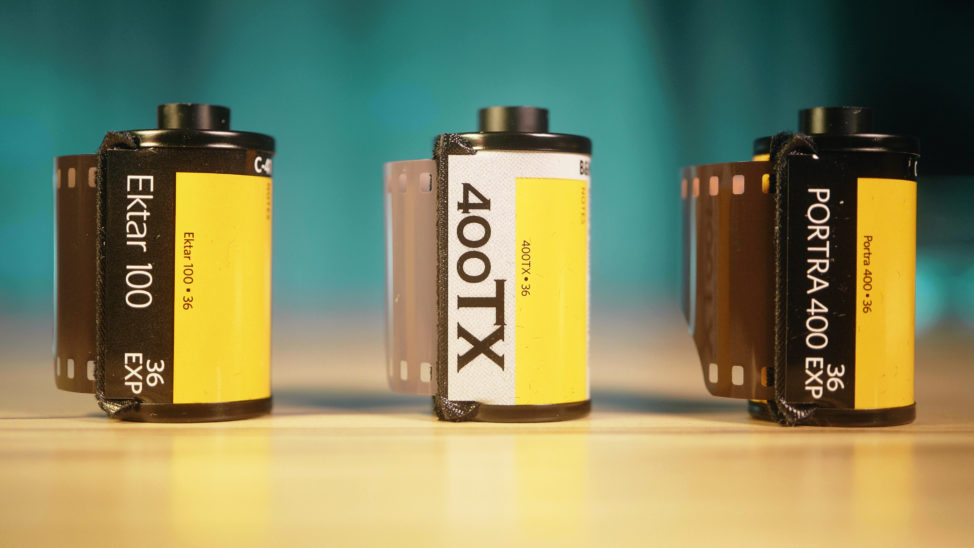
The 35mm has established itself as the major format of the silver age, and not for nothing: it is an excellent compromise between quality, compactness and price.
You will mainly find 3 types of 35mm film cameras.
1. Film reflex cameras
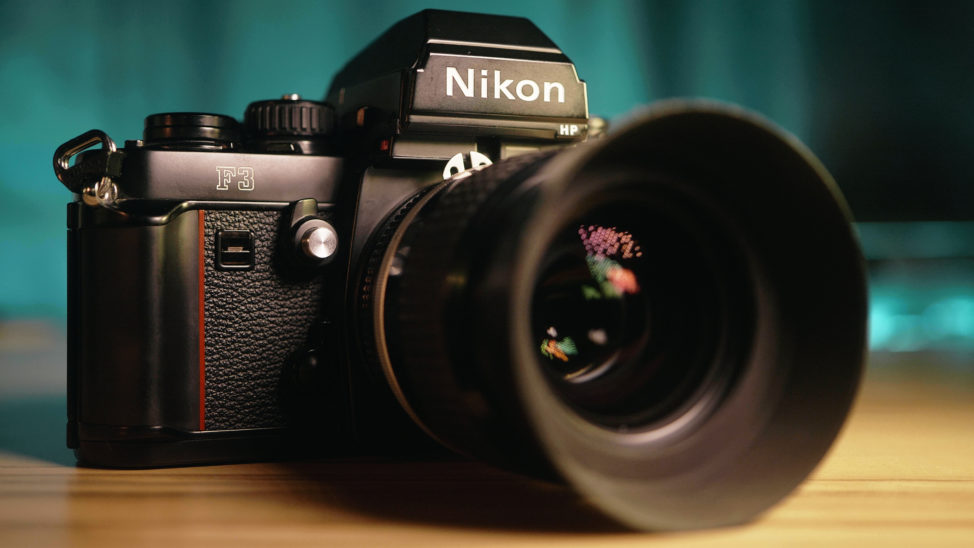
The SLRs work exactly on the same principle as DSLRs (well, it’s rather the opposite 😉 ): the light passes through the lens, bounces off the mirror and then into the prism, passes through the viewfinder and arrives in your eye.
The moment you shoot, the mirror is raised, the shutter is raised, and the sensitive surface is exposed (whether it’s a photo film or a sensor, it works the same way).
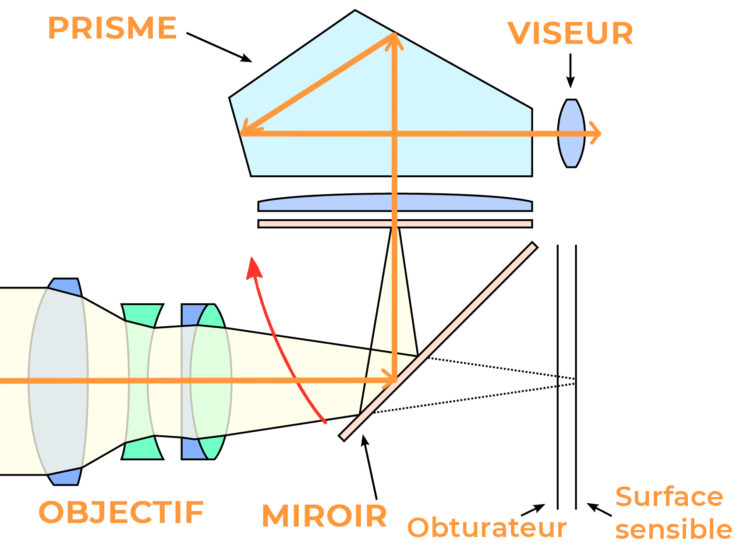
This format has the advantage of being familiar for most of you: if you’ve never touched a film camera in your life, you’ve probably already touched a digital SLR. You won’t be out of place.
Reflexes have interchangeable lenses and therefore really adapt to your shooting style, and some recent SLRs even have autofocus! You’ll find the digital comfort in argentic (we will talk about the precise models a little further down).
2. Telemetry devices
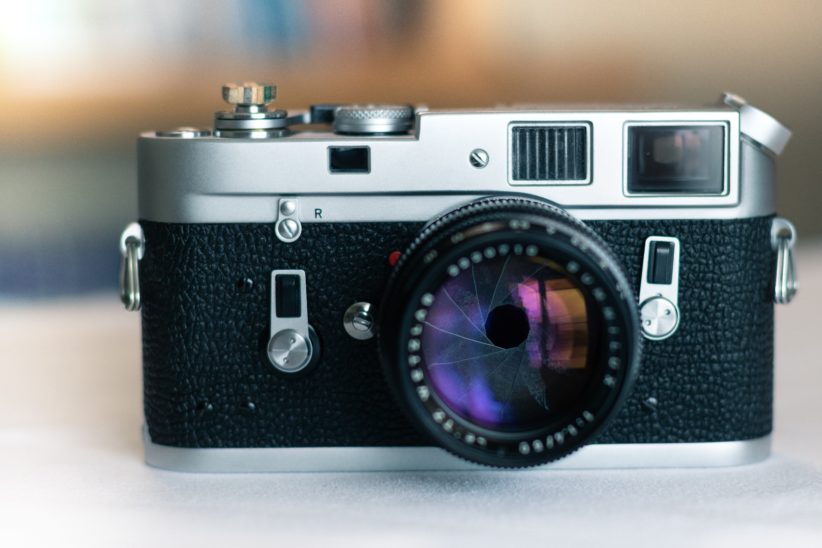
A family of devices that is almost unknown to photographers who have only known digital photography.is that of the devices telemetry.
They’re called that because they use a special focus the viewfinder is offset from the lens, and you don’t aim through the lens…like a reflex.
You are probably familiar with Leica telemeters, which are typical for this camera format. This type of camera (and especially the Leica) has been used extensively by great street photographers like Henri Cartier-Bresson or Joel Meyerowitzwhich contributed a little to their legend.
Indeed, at the time, it was undoubtedly the most suitable technology for street photography.
This has advantages and disadvantages:
- Don’t you see not exactly the scene photographed. There is usually a parallax correction in the viewfinder to avoid this, but for example if you have your finger in front of the lens, you won’t see it, unlike an SLR.
- The viewfinder frame can be wider than your focal length (with a colored frame to show you how to frame), which allows you to see a subject arriving in the frame.
- There’s no mirror pitchwhich allows a much quieter operation than that of a reflex camera.
- The devices are much smaller.
3. The silver compacts
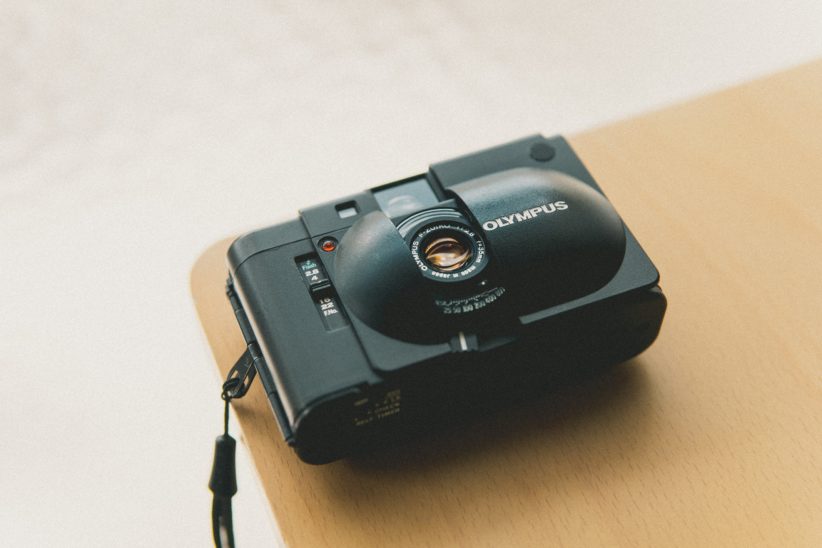
There are also 35mm silver compacts. And there are MANY different models. You will find all the prices and qualities (we will come back to this later), with the advantage of a high compactness while keeping a 35mm film (so a full frame equivalent, it’s crazy when you think about it!)..
You will have often autofocus on the compacts, but not always the possibility to make manual adjustments. Indeed, they were often designed for the amateur, in a philosophy “point and shoot“( Aiming and clicking ) That said, some still allow these settings, but they are usually more expensive.
Given the very reasonable price of some models, they can be a very good entry door to filmand give you very satisfactory results.
4. Half-formats
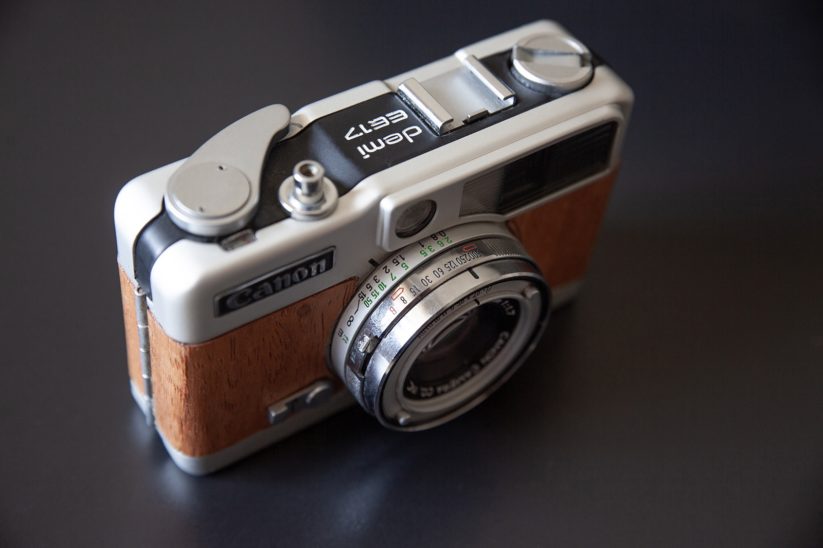
So no, half-format is not the insult that the big cameras were making to the little ones in the playground 😀
These are simply devices that make a photo on half of the 35mm format. Hence the name “half-format”.
So it’s no longer 24x36mm format, but I include them here because they still use 35mm film, so they count in this film format.
Can you imagine that…use a smaller sensitive surface area allows them to be more compact. They were often intended for those who wanted compactness with more professional features, and so we’ll even find some interchangeable lens models like the Olympus Pen, and certainly with manual or semi-automatic settings.
That said, you still lose quite a bit in quality given the final size of the negative, and you’re going to see more of the film’s grain (which we can look for, of course). And of course, like any smaller “sensor”, it will be harder to get a shallow depth of field.
120″ format cameras
As we saw in the first article of this dossier, there is also another relatively common film: the 120 formatwhich is used in conjunction with what are called medium-format devices.
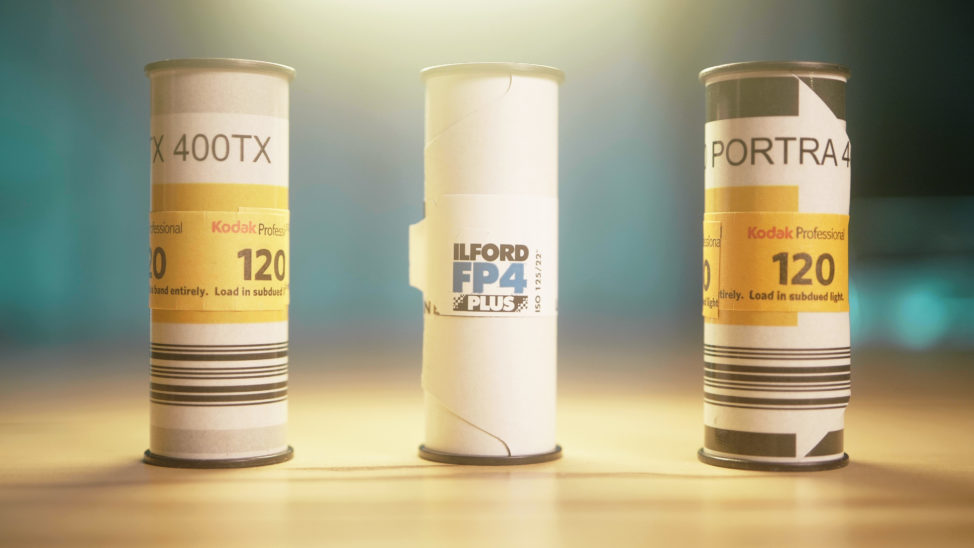
The negative is much larger than the 35mm. (surface area on average between 3 and 5 times larger!), which has advantages and disadvantages that will apply to all medium-format film cameras.
For me, the question of the choice between 35mm and medium format does not really arise: it’s more one AND the other than one OR the other..
Both formats have different usesand everyone has their advantages and disadvantages. Personally, I use different cameras depending on my photographic lenses. I detail this idea more in this video:
Anyway, I think the possibility to photograph in medium format is one of the great advantages of film todayso I advise you to take an interest in it 🙂.
So let’s review the different types of devices you can find in medium format (you’ll see, it’s going to be a bit funky!).
1. Medium-format silver reflex cameras
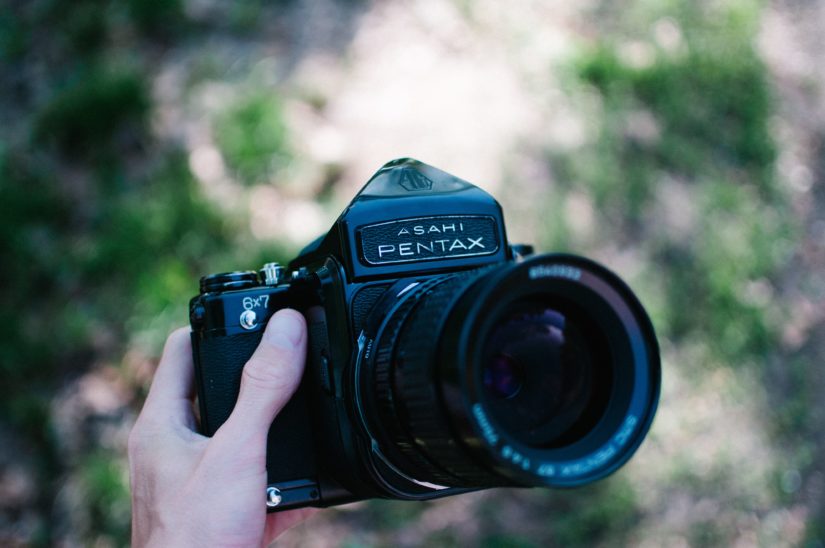
Let’s start with what won’t make you feel too out of place: reflexes! And yes, there are reflex cameras in medium format too. If you take a Pentax 67 for example (more about that below), it looks exactly like a 35mm SLR.except he’s bigger one. It’s exactly the same principle!
2. The telemetric medium formats
As for 35mm, there are also some telemetric medium-format cameraswith their particular focus.
The advantage is obvious: medium-format cameras are inherently larger due to the size of the negative, the rangefinder sighting compensates for this by reducing the size of the boxes a little bit.
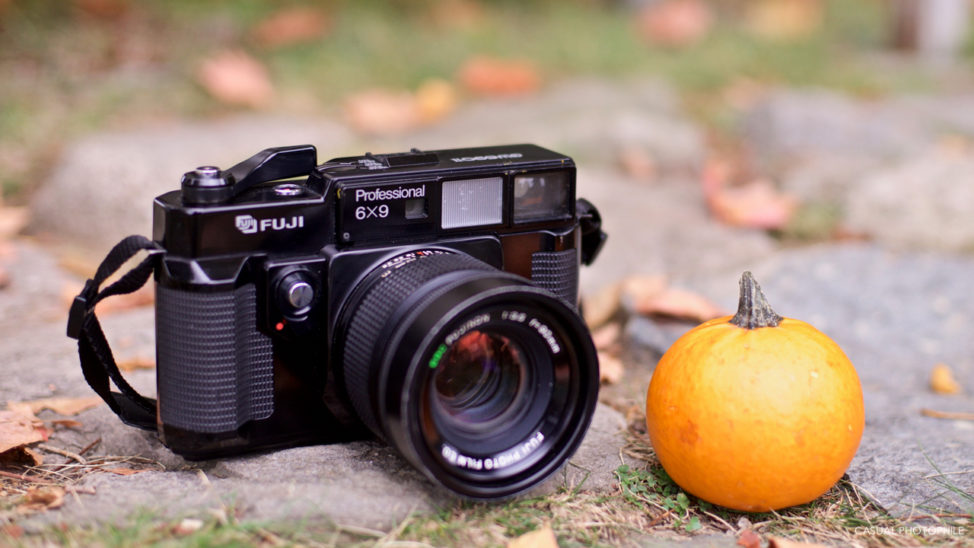
For example, there is the Fuji GW690a 6×9 format camera, called the “Texas Leica“because it looks like a Leica, but much more imposing! (It must be because of the big Texas pickups, what do you want?)
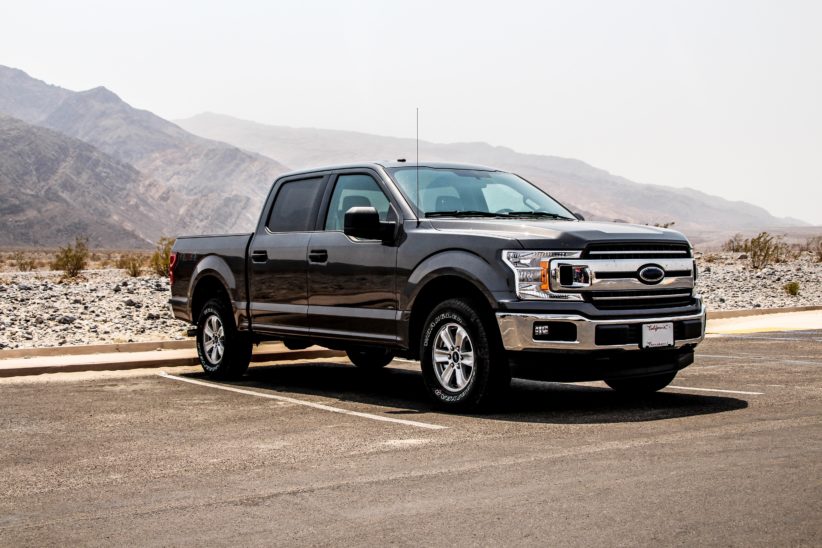
Some devices have gone even further by allowing the optics to be retractto make it even more compact.
3. 3. SLR or TLR cameras
(In English “twin-lens reflex”, abbreviated TLR)
Here we come to what medium format does best: cameras that are a bit weird if you don’t know silver. Especially since the first models of this type date back to the late 19th century !
Two-lens reflex cameras are cameras that use… two objectives ! Yeah, I know, you didn’t guess.
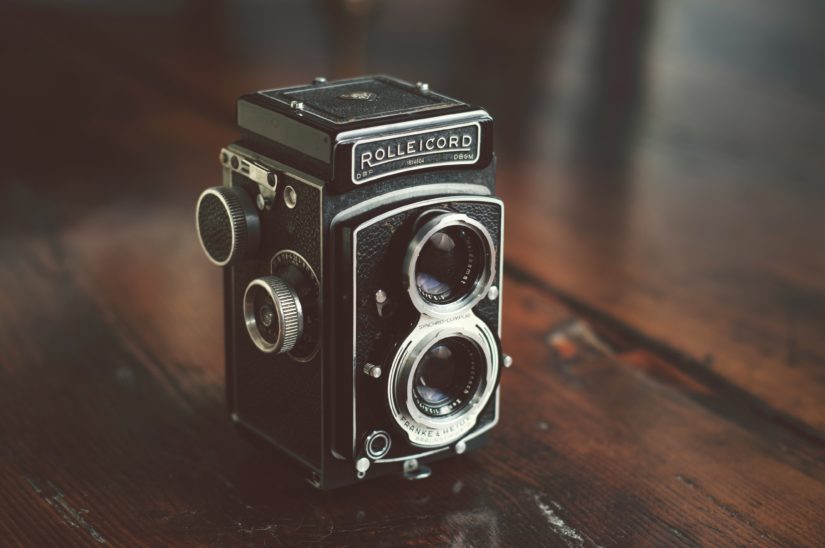
Then by what sorcery would you tell me?
Well… the bottom lens is used for shooting (the shutter will open to expose the film), and the top lens is used for aiming he’s going to project the image onto a frosted glass, which you’re going to look down. This is the first characteristic of an LRT: you’re not going to aim for the eye, you’re going to aim for the chest….
It changes the point of view a lot.and that can be a reason to love this format or hate it, depending on your preferences.
This is the type of device used by the famous Vivian Maier or Diane Arbus.
Another consequence of this aim is that the image is reversed horizontally you will see the right on the left of the frame, and vice versa. It’s quite confusing at first glance, and it takes some getting used to it to aim correctly.
It’s got a aftereffect rather positive on the other hand: it forces you to be precise in your compositions…since you’re having more trouble. Love it or hate it!
Last point: LRTs are still at the square format 6×6…by design. Here again: you either love or hate it, the square being really a particular frame format, with its advantages and disadvantages. I talk about it in my article on aspect ratio here.
4. Modular medium-format cameras
Finally, I absolutely must tell you about one last large family of devices that are very interesting: what we can call “modular devices”.
So technically, they’re single-lens reflex cameras.so I could (should?) have put them up higher. But I preferred to separate them to underline their very different philosophy.
The principle is simple: everything comes apart like Legos.
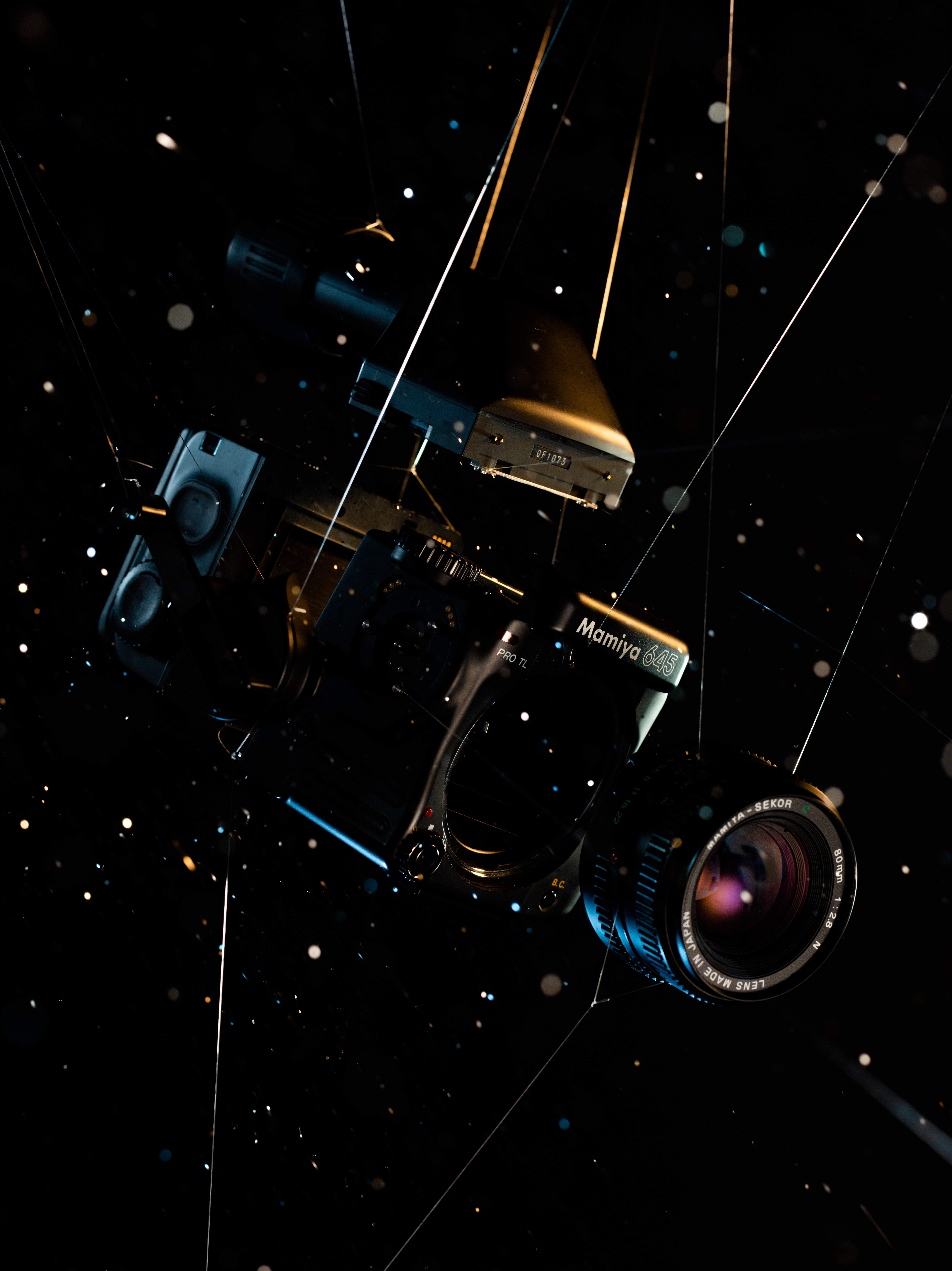
Basically, you have some kind of cube in the centre, which contains the shutter of the camera. And on top of that, you’ll be able to attach:
- of objectives sure enough
- of sights different:
- prism retrospectively
- chest viewfinder like on a LRT
- of backwhich contain the film, and can be of different formats depending on the camera. (for example we can make 6×4.5 and 6×6 with the same case but a different back)
- and sometimes even handles or other accessories to improve ergonomics
The advantage of this modular side is thatwith the same housing, you can have many different possibilities.
On the Mamiya 645 for example, you can have it one day in compact modewith a folded chest viewfinder, without a handle; and the next day in pro modewith a prism with exposure metering cell, and a motorized handle that improves ergonomics and automatically rewinds the film.
The biggest advantage of modular systems is the ability to change one’s back One of the weaknesses of film is that once a film is loaded into the camera, you have to go all the way. If you feel like doing black and white instead of colour, or if you need a different ISO sensitivity, there’s nothing you can do about it except change the camera body.
With interchangeable spines, you can leave your unfinished ISO 400 colour film in one spine and put another one in which you will load ISO 3200 black and white film. And depending on the backs you have, you can also change the aspect ratio, for example from 6×6 to 6×4.5!
This type of system exists in all major medium formats: 6×4.5, 6×6, 6×7. I will present some of them in the selection of devices below.
Large-format cameras
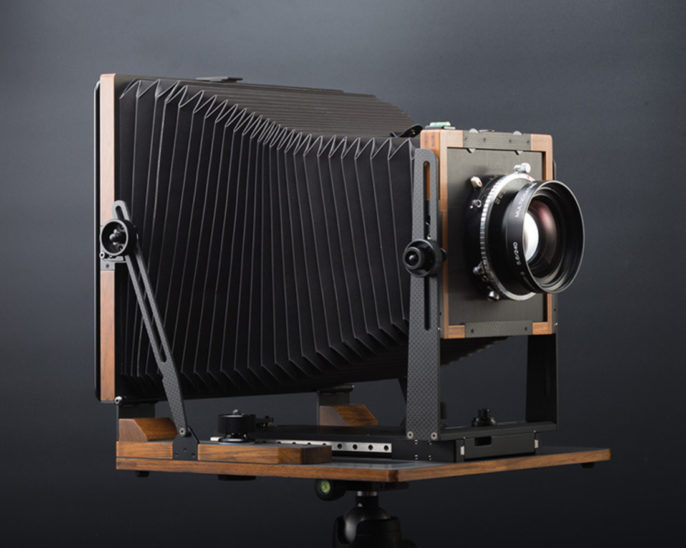
This file wouldn’t be complete if I didn’t tell you about the wide formats, namely the photographic chambers.
When you don’t know and you see a room, you’d think it’s a complex device…. And if indeed his use is delicate (since you can totally say goodbye to any automatism), its design is actually straightforward.
You have a objectivewhich projects the image onto a frosted glass (the image is thus upside down horizontallyas on a bi-lens reflex, but also vertically !). Between the two, only one bellows Isolate from the light.
So you’re going to focus with a magnifying glass on the frosted glassand then insert a cassette that contains your film. You will then remove the mask so that the film can be exposed, and after making your adjustments on the lens, expose the film plane. You will then put the mask back on to avoid exposing the film in broad daylight, and voila, you have taken a picture!
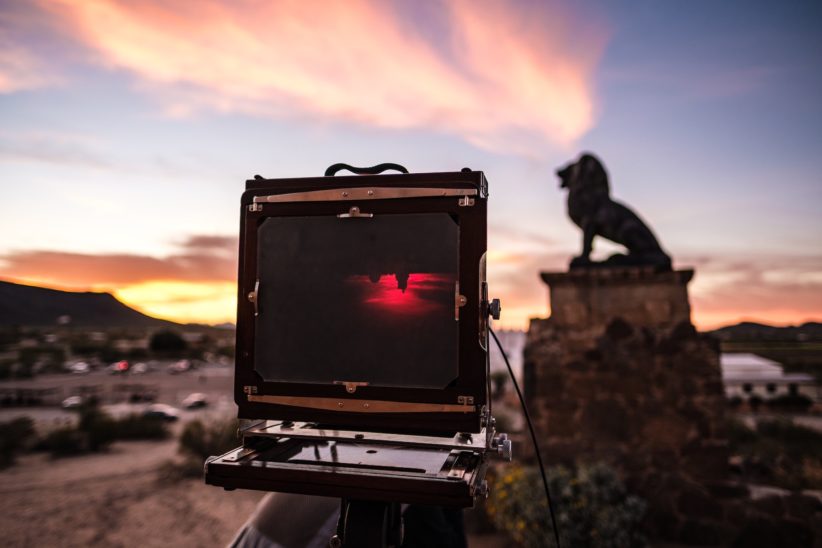
What’s fascinating is that, concretely, you do manually everything that modern appliances do for you. This is probably the “purest” form of photography, if you can call it that (without misplaced nostalgia of course: the result partially resulting from the automatisms of a camera is just as valid of course, since you always have your hand on it).
We’re not gonna lie to each other: I would advise you not to start taking film photography directly from the camera…. There are many complications, and it might discourage you.
The benefits are not negligible, however, and it is a format that may be very suitable for some projects, especially in two important respects:
- Quality remains unmatched we’re talking about a sensitive surface between 14 and 55 times larger than 24x36mm. It’s absolutely giganticand most photographic artists who make very large prints of their work still use the camera to achieve such quality. This is for example the case of Gregory Crewdson and Andreas Gursky, whom I have already mentioned on the channel:
- Next, the camera has a very imposing and traditional lookand also imposes a certain slowness at the shooting. You might think these are disadvantages, but it can depend on what you’re doing: there are many photographers who use this to their advantage for portraiture. The formalism of the camera allows them to take their timeand creates a certain reaction in their subjects. Joel Meyerowitz explains that he did this for his project… Provincetown for example, recently released:
What is the best film camera?
I’ll bring you down right away: there’s obviously no answer to that question.. The best device depends on your needsyour preferences or even the photography project considered. No technology is perfect (in any field), so it will necessarily be a compromise between the different aspects that come into play in the choice.
As usual, I don’t want to point you to a particular model and say “take this”, because that would not make sense. What I want to do is arm you to make a relevant choice for yourself.
Which film camera to choose to start with?
In this article, I really want to deal with all the possibilities (including if you already have a film but want to go further). But I know that many of you are simply asking yourselves the question: what is the best camera to start with for silver photography?
Clearly, I would advise you to start in 35mm. This is where you will be the least lost, where it will be the easiest for you, and also where you can start at a low cost.
Any 35mm camera will be fine, but if you’re used to having your hands on the settings, maybe exclude the compacts for the moment (I think it’s cool to have one in the long run, but at the beginning it’s good to master a little bit what you do and to find your marks).
An old-fashioned reflex camera will probably be a good choice for most people. : you will find a known ergonomics, it’s generally rather beautiful and you will find inexpensive models.
You can also take a modern SLR camera with all automatisms It has less charm, but you’ll have fewer misfires, and if you’re just looking for the look and feel of film without the hassle, it might be perfect for you.
A telemetry may also do the trick, but not everyone likes it. (especially if you’re aiming for the right eye), so I advise you totry before you buyFor example, by asking around you if anyone has a telemetry device to lend to see how it looks.
What are the criteria for buying a film camera?
Before moving on to the selection of models that I propose to you to clear the silver market, we must think about what criteria to take into account when choosing a case.
Choosing the right device family
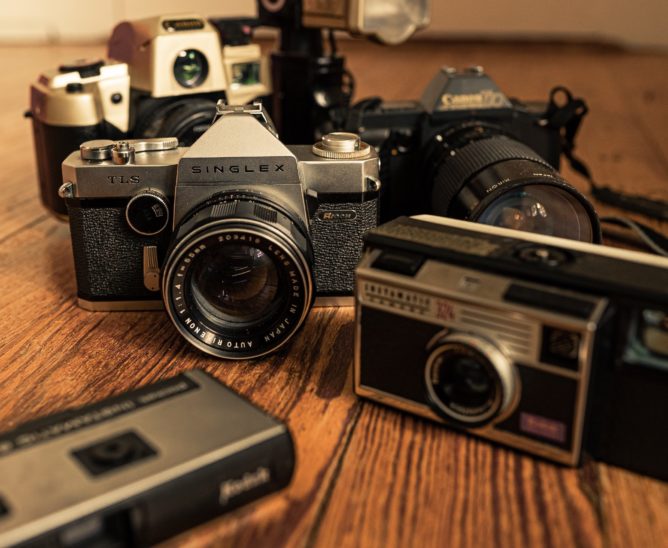
With the panorama I just gave you, you should be… have a good idea of the family of devices you need.. It depends on your needs and preferences, and we can say that a camera from one family doesn’t really compete with another: between a 35mm SLR and a medium format rangefinder, there are trop of differences to really compare them.
So that’s the first choice to make.
Are the lenses interchangeable or not?
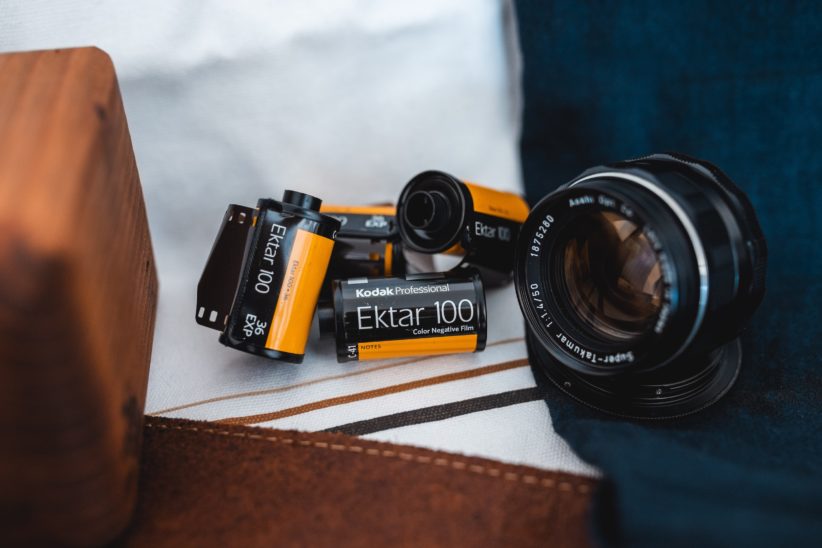
As far as I know, most of my readers (cuckoo!) have a camera with interchangeable lensessimply for the versatility that it brings.
In film, you won’t always have this possibility, and it’s not always the case. never mind. Some models have a fixed focal length, but may be just right for you if it suits your work.
For example, on my Nikon F3, which has interchangeable lenses, I’m only using about a 35mm.. So I could settle for this if it was fixed.
Many photographers use the same focal length most of the time, even two or three maximum. So it’s not necessarily a problem, but it’s obviously an important purchasing criterion.
The presence of a light measuring cell
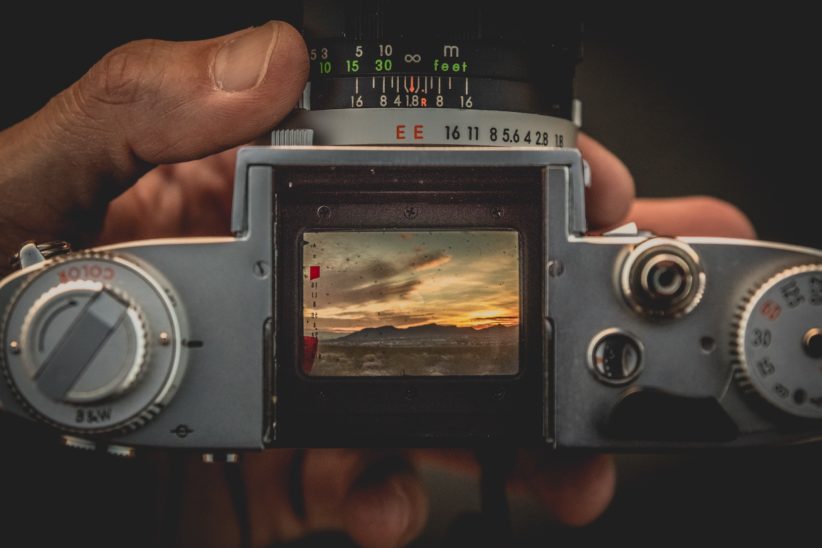
In digital, all cameras measure light, but as I said before, it is not as automatic in film.
As you can imagine: Having an exposure meter on the camera will obviously make your life a lot easier.. It’s better to have one, clearly, but you can do without it, especially if you don’t need to be too reactive to changes in light.
Personally I generally recommend you to choose devices with measurementbut in some cases it can be justified to take one without, especially to have access to certain models without putting the high price (I think of the medium format for example).
The presence of semi-automatic modes
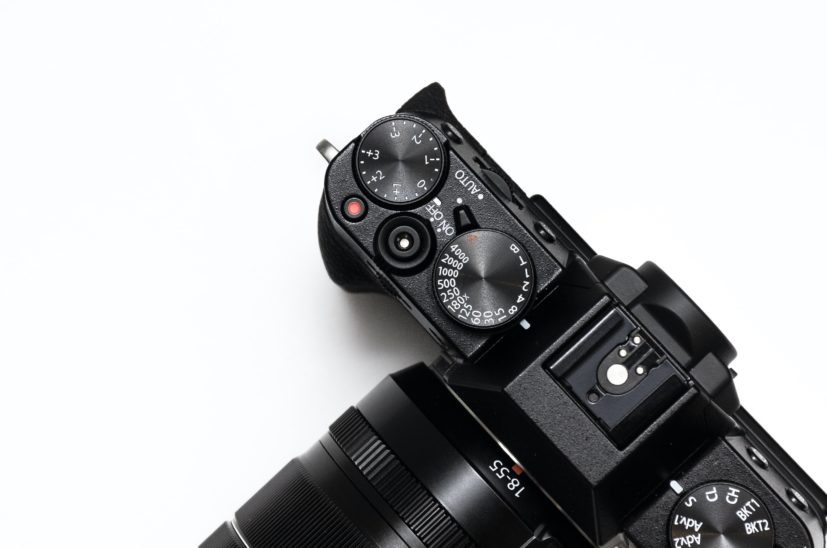
Some cameras will have priority over aperture, shutter speed, or both. You know my opinion on manual mode: I think if you can avoid it, it’s better.
So I find It is better to have this kind of mode on a silver camera.but that obviously implies that the measure is good. Indeed, unlike digital, you can’t check that it’s well exposed right away, so you have to be a little more careful.
That said, the Manual mode won’t work miracles either, because you won’t be able to check the exposure. Simply, it will allow you to regain control if necessary, but anyway it is present in most film cameras, except for the fully automatic compacts.
We’ll see how to exhibit in a future video.
Manual or automatic focusing?
As I told you before, in film you can find both automatic and manual focus cameras.
For medium formatsyou have a few autofocus models, but… the overwhelming majority will be manual focus..
On the other hand, in 35mmyou can totally find autofocus bodieswhether it’s among the reflexes of the 2000s or the compact ones. It all depends on whether you think it’s indispensable.
Still, note thatit’s probably better to have no autofocus at all than an inaccurate and slow AFhonestly.
The possible sensitivity range
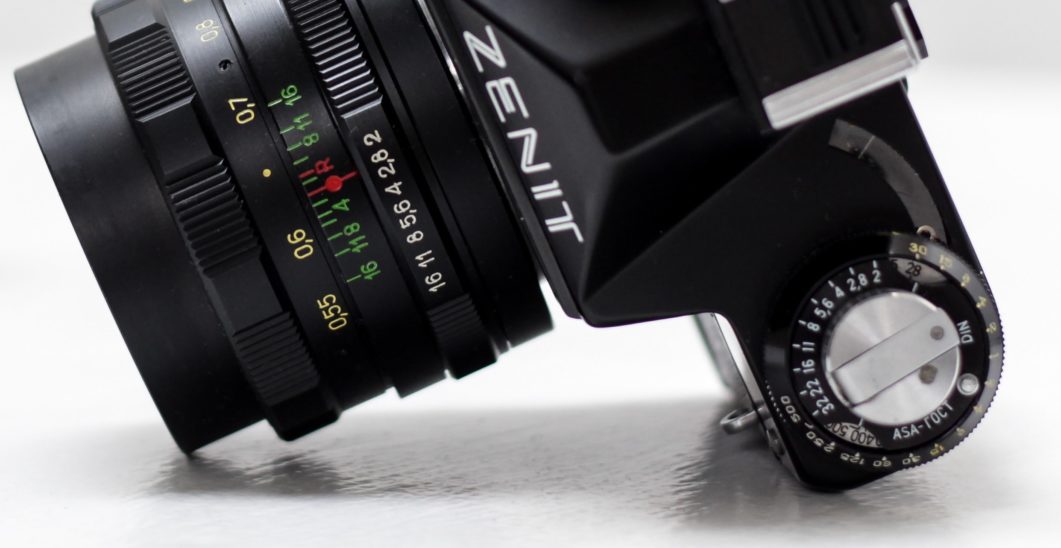
When you put film in your camera, you need to set the ISO sensitivity to match that of the film.and so that the exposure parameters used by the camera are the right ones: it makes sense.
But depending on the model, you have a different latitude to set your ISOs. For example, for example, some may be limited to ISO 400This prevents you from using the semi-automatic modes if you wish to use more sensitive film.
That doesn’t make it impossible to take the shot: in the absolute, just switch back to Manual mode to make up for that difference. But in this case, you’ll have to either use an external cell (and transfer the values directly to the unit), or make a small mental arithmetic to compensate for the measurement given by the instrument.
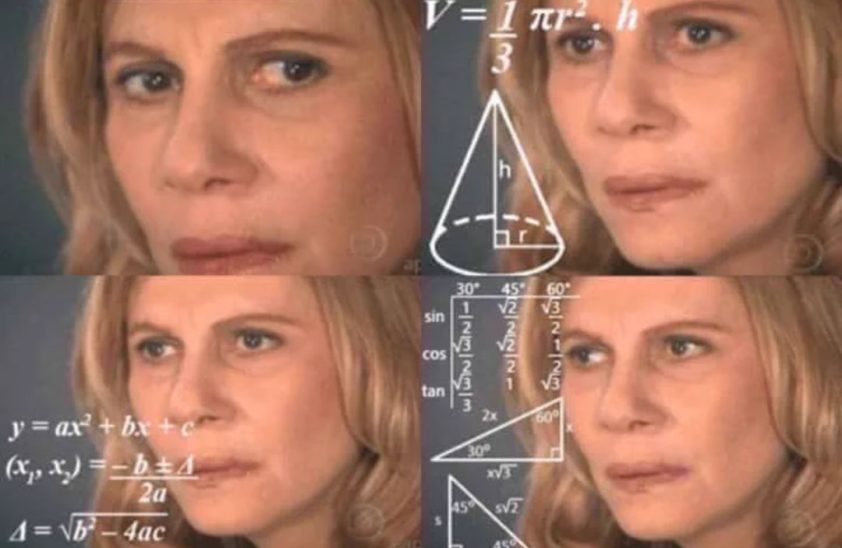
For example, if you put in ISO 800 film, but the camera setting is only up to ISO 400, the camera will think that the film has half the sensitivity of the real thing.. It will set the aperture and shutter speed to send twice as much light onto the film, i.e. overexposing it by one stop.
To avoid that, you’ll need dim the light from a stop signwith the aperture or shutter speed.
In short, if you plan to use sensitive film (ISO 800 or more) and you are not very good at mental arithmetic (or you just don’t feel like it), you’ll have to check this criterion when choosing a camera.
Shutter speed range

In digital, if there’s one problem you never have, it’s to have too of light.
Not enough light. Happens all the time.This is why manufacturers are still fighting to increase the sensitivity of sensors and to be able to see in the dark.
But if you have too much digital light (e.g. if it’s sunny and you want to shoot at f/1.4 to get a nice background blur)it’s very simple: you just have to lower ISO sensitivityor to use a faster shutter speed (sometimes very fast, like 1/8000th).
But in film, once you put a film in the camera, you have to finish it before changing it (well, you don’t have to, but let’s just say it would be a shame to waste it!).
So imagine: you have a 400 ISO film in your camera, which is quite versatile and usually allows you to shoot both in sunny and cloudy weather, or even at the end of the day.
But today, it’s sunny, and you’d like to shoot a portrait at full aperture. Like the sensitivity is locked at ISO 400, you will have to use a very fast shutter speed. to avoid overexposing the photo.
On the most modern film cameras, the shutter speed can be as fast as 1/4000th without any problem. But on many older cameras, it sometimes stops much earlier, at 1/500th for example. And in this situation, that can be a problem!
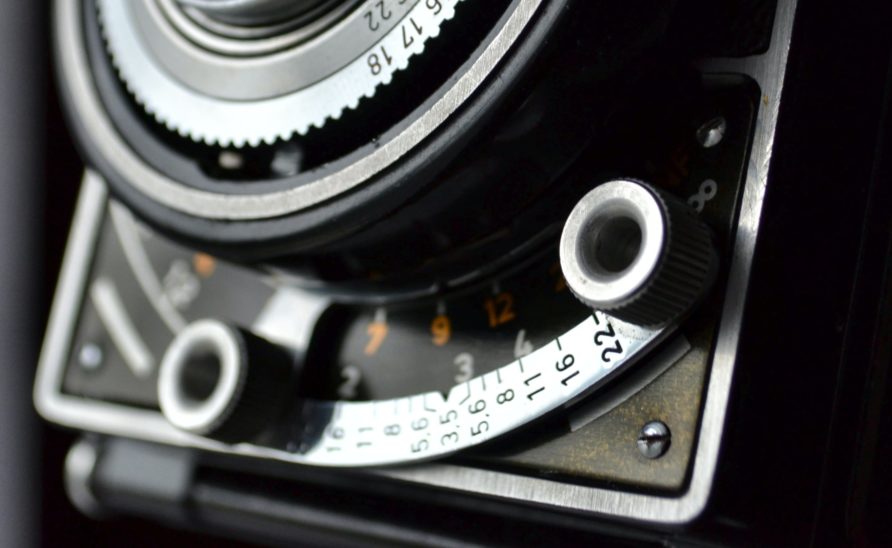
If you have a device that doesn’t go beyond 1/500th, you’re going to have to make a choice :
- Either close the diaphragm furtherand so much for the background blur.
- Either seriously overexpose the image (the film supports a little overexposure, but still avoid several stops of difference)
- Either use an ND filter (still you have to have one, and want to bother with it)
In short, it is a criterion to watch, which may or may not be important to you. It’s up to you!
Ancillary functions
In addition to this, the devices may or may not have additional functions that may be of interest to you, for example :
- The exposure compensation to more finely control your exposure
- The measurement procedures different to better control certain situations such as backlighting.
- The two-fold exhibition (very funny to do in film)
They’re not indispensable, but it’s always nice to have them.
The stack format
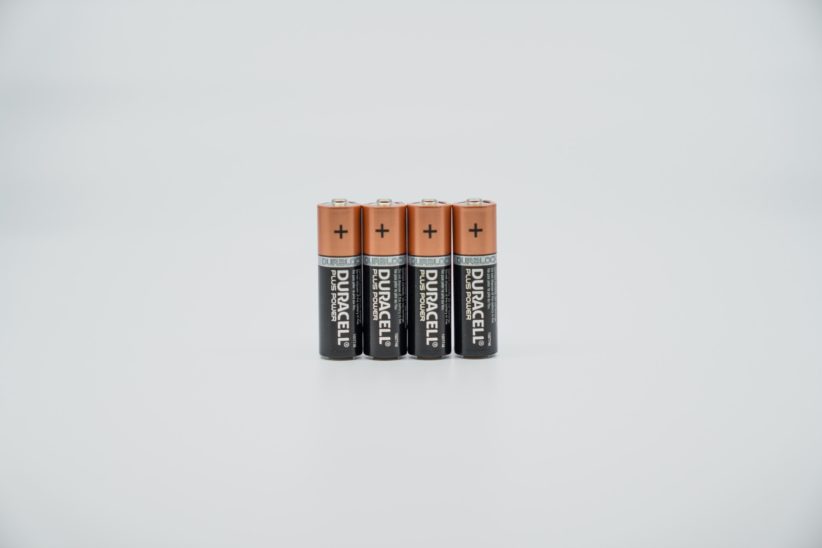
In digital, we don’t really ask ourselves the question anymore because the battery comes with it, and in any case it changes in almost every device.
But in film, the cameras use batteries. Yeah, yeah, just like in your clock radio. (what do you mean, nobody uses a clock radio anymore? :D).
It’s always interesting to know what type of battery your device usesbecause they are not always easy to find, and even in rare cases they are no longer available (usually there is a replacement, but this sometimes leads to unreliability of the cell).
Price and backwards compatibility of objectives
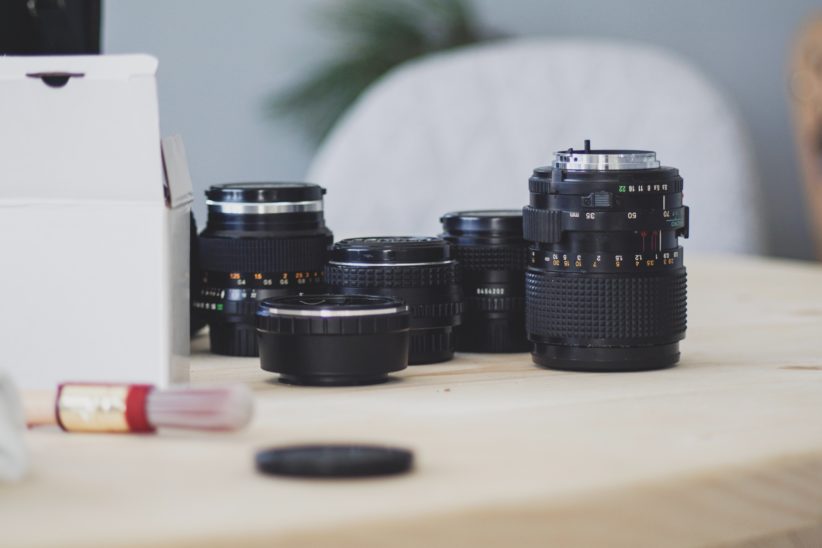
If you choose a camera with interchangeable lenses, you will obviously have to buy lenses.
And in this case, an important criterion may be the price of the lenses of the frame in question.
An interesting example is the Canon à FD mount (e.g. the famous Canon A1, AE-1 and AE-1 Program, which you will often find in your searches). Cannon having frame change with the appearance of the Canon EOS reflex cameras (this is the EF mount), FD-mount lenses are very inexpensive today.. So you can have a small Canon SLR and some lenses for a really reasonable price.
On the contrary, Nikon has decided to keep the same mount…. The advantage is that if you already have a Nikon digital SLR, you can use the lenses on Nikon SLR cameras. ! (Sometimes with the loss of some recent functions of course: you’re not going to magically have autofocus on a camera from the 70’s 😉 )
The disadvantage is that the old lenses are still usable on recent DSLRs, they are more expensive than the ones in Canon FD mount.
Anyway, it might be nice to take a look at this before committing to a format! 🙂
My selection of film cameras
Now that you have in mind both the major families of aircraft, and the criteria to pay attention to, it’s time for me to give you an selection of interesting film cameras.
Attention this selection is obviously not not exhaustivebecause that would be impossible. You don’t have to come and tell me “Laurent, why didn’t you mention [insérer ici mon appareil préféré] ?!” The answer is: “because I can’t put it all on.” !
It is not there either to systematically offer you the best quality/price ratio by category (we will speak again below where to look for it).
So I’m just offering you the most famous models, in all price ranges. The idea is that you have a very good overview of what existsand that when you see a device afterwards you’ll be able to tell yourself “Oh, yeah, he’s kind of like the F500 thingy, but with this missing.”.
Note that unlike digital, where as a general rule a camera that is 3 times more expensive than another has more technical qualities (even if it doesn’t mean it’s better for you), in film, it’s a bit more complicated.
There are added scarcity effects (a little manufactured or older device could be more expensive, of course), but also to pure “hype” It only takes a case seen in the hands of a celebrity to make its price skyrocket. Beyond that, some cameras enjoy (rightly or wrongly) a certain aura, so prices will always be quite high (typically Leica and Hasselblad).

I’m going to mention some of these boxes here from time to time, but I’ll tell you if they’re one of those devices that are probably a little bit too high.
And of course, I’m going to sort by family of devices, so that I can organize this a little bit. Let’s go!
Selection of 35mm film cameras
Selection of 35mm SLR cameras
Let’s start with the 35mm reflexwhich is probably the type of device that most of you will start with. You’re going to see that you basically have a choice between:
- of relatively new models who have all modern functions (autofocus, advanced light metering, automatic film advance)but have the defect of not not look good (they look a lot like today’s DSLRs : it’s not filthy but not particularly pretty either). These are the Nikon F recent or the Canon EOS for example.
- of older models à manual focuswhich still often have an effective light measurement. Their advantage is their look which is always good.
So let’s review some interesting ranges for all budgets.
Modern Nikon autofocus cameras
The first line I want to talk to you about is the one of Modern Nikon autofocus.
(As a reminder, modern Nikon lenses still work on most of the old cameras, although I invite you to check the compatibility with a little Google search 🙂 )
First of all, you have the prosumer range (enlightened amateur if you prefer), which would be a bit like today’s Nikon D7XXX, basically. They are not intended for the pros but have a lot of advanced features and are of very good quality.
The king of this category is undoubtedly the Nikon F100with its fast autofocus, highly efficient metering, and automatic film advance. The F80 and F90 are also to be considered: a little less advanced, and without “all-weather” construction, but also much cheaper on the second-hand market.
In the top range, you will find modern Nikon SLRs for professional use, i.e. the F4, F5 and F6.
The autofocus of the F4 is not seemingly crazy (those were the beginnings), but the F5 and F6 seem to work well on this aspect. That said, the F5 is very bigand doesn’t have many more functions than an F100. And the F6 is very expensive usedespecially because it has the aura of being the last professional SLR still produced by Nikon (you can still find it new for… 2400€ !).
Nikon’s without autofocus
Before the appearance of the “modern” range, Nikon also made very good cameras.
Let’s talk about the Nikon F first of all. Appearing in 1959, it’s probably the first really popular 35mm reflex. It will be replaced later by the Nikon F2 then F3in 1971 and 1980, respectively.
All this range has interchangeable sights, so you will find models without measurement or with measurement, and even chest sights like on the TLR!
I have a personal crush on the F3, which I find beautiful (and the noise of the shutter release is sublime), but it is the generation from which this range becomes electronic, i.e. the camera will not work without batteries. Well, it will, but only at 1/80th. Previous generations used the battery only for light measurement.
Some people don’t like it, but I don’t quite understand the argument: we’re used to walking around with 3 spare batteries for our digital cameras, and we can’t keep a tiny battery in our camera bag just in case? 🤷♂️
Then you have the range “below” but with extremely qualitative devices as well. There is the family FE (for Electronic), the shutter of which is electronicsand the family FMwhose shutter is… mechanics ! For once, a device name is clear enough 🙂
It might take a full article to summarize the differences between these different devices, but they’re all pretty attractive. I refer you to Ken Rockwell’s site for a complete comparison chart… (in English, but it’s simple so the automatic translation of your browser will help you 🙂 ).
Still, note the FM3athe last manual focus reflex camera produced by Nikon (from 2001 to 2006!), which has a bit of a mythical status, as it brings together the advantages of the two ranges FM and FE, without their disadvantages. As you can imagine, this makes it a rather expensive case, although you can probably have it for the next decades without any worries.
The Canon FD range
Enough about Nikon, let’s talk about Canon! What interests us the most is the range of cameras in FD mount.
She’s a little equivalent to Nikon’s non-auto-focus range (you’ll see that it’s a classic SLR look before the appearance of AF), but its main advantage is that the FD mount was dropped by Canon when switching to autofocus. (which saw the brand change to the EF mount, still in use today).
The disadvantage is that your modern Canon lenses don’t workthe advantage is that FD-mount lenses are quite affordable.
The best known are the Canon A1, AE-1 and AE-1 Program. They are all relatively affordable, and have some rather minor differences in the end, especially on the available shooting modes (the AE-1 only has shutter priority for example). I’ll let you see the summary in the tables, but I’ve seen a lot of people say that they consider the A1 to be the best in absolute terms (without taking into account the price/quality ratio of course).
While the “Canon A” family has an electronic shutter, the “Canon B” family has an electronic shutter. Canon Fhas a mechanical shutter. These are quite credible cameras as well, just a bit heavier since they were designed for pros.
Olympus OM
It’s not just Canon and Nikon in life, and the other brands were also producing good cameras at the time. What’s notable is especially their slightly smaller size compared to the competition.
The OM-1 à OM-4 are the top of the line at Olympus, and it is important to remember that the OM-1 and OM-3 are fully manuals, while the OM-2 and OM-4 include an opening priority mode..
OM-3 is expensive because it is rare, but this is not necessarily justified by its functions (it is very similar to OM-1). The most popular is undoubtedly OM-2.which has an opening priority mode without reaching the price of the (more recent) OM-4.
The range below the “double-digit OM” (OM-10 to OM-40) is also to be considered to save a little in budget.
Minolta’s SLR cameras
The brand’s photo division was bought in 2006 by Sony (and it worked out pretty well for them!), but it was a pioneer in many areas (autofocus, speed priority, stabilization, …).
Unsurprisingly, it has therefore produced some interesting devices, which are now at reasonable prices (which I think is helped by the fact that the younger ones don’t even know the brand name :D).
The Minolta XD was the latest high-end camera from Minolta, and can be found at a very reasonable price. (be careful, it was named XD in Japan, but XD7 in Europe and XD11 in the US, so you can find all these names…). It’s probably their best manual focus camera, with manual mode, aperture priority, and shutter speed priority.
We can also cite the Minolta SRT-101which you can find a test on Benber’s blog. Its technical data sheet is quite standard compared to the rest of what you can find here, but knowing that it was released in 1966 it’s quite impressive!
Finally, we cannot fail to mention the “X series”, and in particular the very popular X700 (with Program mode) and X500 (called X570 in the USA) which does not have a program mode, just the opening priority.
Pentax SLR cameras
Along with Nikon, Pentax is the only range that offers backward lens compatibility.. If you are one of the last ones who resist with Pentax digital equipment, already congratulations :D, but also you will be able to use it on old Pentax devices (even if here again, do your research before, there are always special cases).
The most popular model is undoubtedly the Pentax K1000, in particular because it was produced for… 21 years and sold more than 3 million units! It’s a change from today’s models 😀
It has a cell but remains at manual tuningBut you will find it for a reasonable price (at 3 million copies, it is not exactly rare).
Selection of 35mm silver telemetric rangefinders
Next, let’s move on to a selection of 35mm film telemetry. We can hardly start without talking about Leicaa legendary German brand that introduced the Leica M…the most reputable telemetrics.
It all starts with the M3 at 1954until MP which is still produced today (making it one of the last silver cameras in production in the world). There are also digital Leicas available today.
One of the characteristics of this brand is the price, let’s say… fairly high of its cases. A new MP is currently displayed for the modest sum of 7060€ on Leica’s website. Without a purpose, of course! 😀
The second-hand market obviously offers more reasonable prices that do not necessarily require you to break your PEL, but the aura of this brand remains present, and therefore you’ll always get a 4-digit amount. (not to mention that the optics are not free either…).
The most popular model is probably the Leica M6You will find the characteristics and the price below.
So, should we get a Leica? Is it worth it? Honestly, my point is that no one’s got need of a Leica, but I can understand why we have some envy.
There’s no doubt that these are well-produced devicesThe optical park is of excellent quality, but not everything is pink for all that:
- It is to be expected maintenancebecause a telemeter has to be adjusted from time to time, and that can be a few hundred euros depending on the work.
- The duration argument does not hold, because there are many very robust devices that have been going on for decades and don’t cost that much.
- The quality one doesn’t really hold either: the optics are good, but 35mm film has a definition limit, and it doesn’t say the difference is really noticeable. (but you can convince yourself of this once you put 2000€ in a device :D).
In short, I have nothing against leicaists, and everyone spends their money as they want: it makes perfect sense to me to spend several thousand euros on a box if you are pretty sure to keep it for decades. (in any case more than putting the same amount in the last numerical one, which is barely better than the previous one, that we’ll keep for 3 years).
Still, don’t think that buying a Leica will in itself improve your photographic results. 😉
So what other telemetry can you choose? Well, there are several interesting models.
Let’s start with the most popular: the Canonet ! (Which is often called “the Leica of the poor”, like almost all telemetrics that don’t cost 4 digits :P)
It exists in several variations, including the QL17 G IIIwhich has a 40mm f/1.7and less high-end the Canonet 28whose 40mm opens to… f/2.8 (easy to remember, it’s in the name :D).
The difference is therefore mainly in optics that are not interchangeableand on other criteria that I’ll let you discover below.
Having said that, the little Canonet more than lives up to the comparison. You can find comparisons on the internet, and quite frankly it’s hard to say that the Leica is worth 10 to 20 times more.
I refer you to this comparison for example, where I’m sure that almost nobody would know the difference without having the case marked underneath (look at page 2 and page 3 to see larger pictures).
In addition to the Canonet, there are of course alternatives, such as :
- the Rollei XF35with its 40mm f/2.3 sound but no manual adjustments.
- the Konica C35with the same spirit of automatic adjustments, with a 38mm f/2.8
- The ZorkiThey were designed to be copies of Leica, so much so that they use M39-mount optics, the same as the early Leicas. It’s a bit rustic, but you can find second hand ones for really not much!
Selection of 35mm silver compacts
Rangefinders are a good option for a compact film camera, but we can go even further with the silver compacts..
It’s hard not to start this selection with the Olympus MJUs, in particular the MJU IIwhich reached a near-cult statusand whose prices are therefore soaring (probably a bit too much).
It’s a small box with a 35mm f/2.8which closes with a flap and all in roundness, with a very typical design of the 90s (it was released in 1997). It’s really small, which contributed to its popularity (3.8 million copies sold anyway!), and of course has autofocus.
The MJU I is very slightly larger, a little more angular, but above all has an optic that only opens to f/3.5 and a shutter that will not exceed the 1/500th (compared to 1/1000 for the MJU II). It is therefore objectively less good, but also … much cheaper! (Even if people are starting to refer to it because of the soaring prices of the MJU II)
Another range of very reputable housings are the Contax Ts, including the T2 and the T3. They’re very famous for good reason: the goal was to make a high-end compactand the design of the first model was created jointly by Yashica, Carl Zeiss (well known for their exceptional optics), and… Porsche ! As much as to say that it is not ugly like device 😉
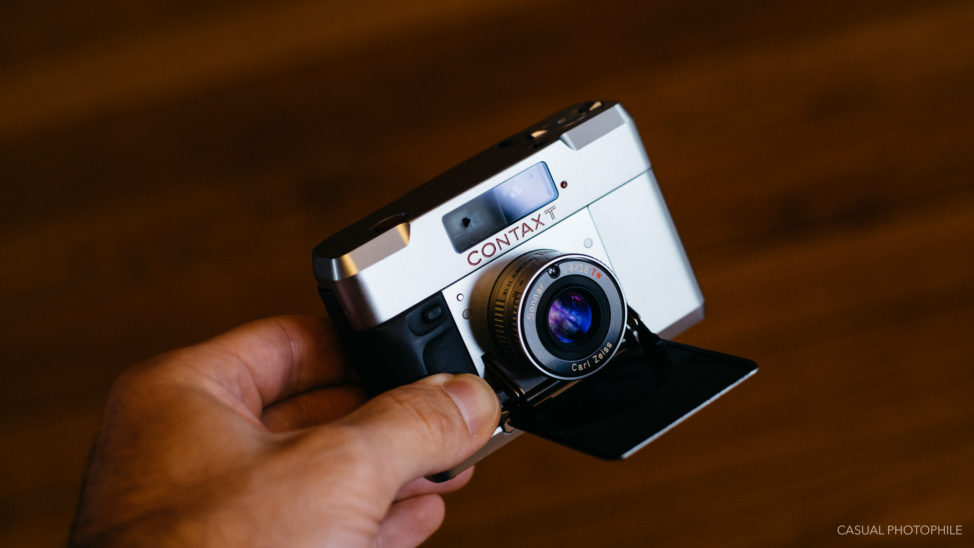
Today, this range, and in particular the T2 and T3 models, have become a little bit of a external signs of wealth because of their presence in the hands of influential people, starting with Kendall Jenner (I understand she is Kim Kardashian’s half-sister 🤷), and more recently Chris Hemsworth (Thor).
People being sheep, prices have soared and the Contax T3 now quietly exceeds 2000€, which is a bit expensive for a 20-year-old compact, however high-end it may be.
I’ll put the specifications of the different models below, but to be clear: the quality/price ratio is not there. These are very good cameras, but the price has gone way too high for non-photographic reasons. You can buy it to please yourself, but don’t think you’ll get a good deal 🙂.
In addition, the family of silver compacts has in general more electronics than others (to control autofocus and auto exposure), and is not designed to last as long as other cameras. Anyway, anyway, breakdowns are more frequentand you can end up with a box that doesn’t work anymore, and irreparable. If it’s a 70€ compact, it’s not so bad, but if you paid a minimum wage, it’s a bit worse…
Others more reasonable models exist. It is a very large family, so it is impossible to make an exhaustive list, but we can mention for example the series of Minox 35which have the advantage of being very compact thanks to their special foldable design. Equipped with a 35mm optic opening at f/2.8, some models such as the Minox 35 PL are unfortunately limited to ISO 400, but the GT rises to ISO 800. (although one variant goes up to ISO 1600) and the GT-E at ISO 1600, so you’ll find your happiness if it’s important to you.
Its major drawback is its manual focus, which has to be judged according to the distance of the subject. And its big quality is its price: you’ll find some models below 100€. no worries, even under 50€!
For more details, you will find the tests of the different Minoxes in French on Benber’s blog.
Finally, I couldn’t forget the family. Olympus XAa bit like the ancestor of Mju II. The two most common models are the XA and XA2, respectively a rangefinder (and yes!) that opens to f/2.8 and a zone-focus device, like the Minox I just mentioned, which opens at f/3.5.
The XA is therefore more accurate in focus. Be careful not to confuse with the XA1, which is another model (a lower-end XA2).
Selection of half-format film cameras
To finish this selection of 35mm cameras, let’s talk about the half-formats. As a reminder, they take pictures on half the surface of a 24x36mm negative, allowing you to take 72 pictures per film.
You’ll mostly meet two families. First of all the Olympus Pen. Introduced in 1959, you have:
- the Pen and then the Pen S, without measurement and without interchangeable lenswith a 28mm f/3.5 or a 30mm f/2.8 according to the versions ;
- the Pen D, D2 and D3 introduce a faster cell and optics, at a lower cost. f/1.9 then 1.7 ;
- the Pen EEwith automatic exposure ;
- and finally the Pen Fs, of the mini-reflex with interchangeable lens !
I personally tested the Pen FTone of the latest models, and I sold it after a film, frustrated by the very dim viewfinder with the f/2.8 pancake optics I had chosen. In any case you can have more compact, so in the end I don’t think it’s such a good choice considering the rest of the silver market.
The second well-known model is the Canon Demi EE17which I personally find incredibly charming, but whose zone-specific focus cools me down.
Selection of medium format film cameras
Now it’s time to move on to the medium sizefor which the diversity of options is much greater Between the different formats you can choose (6×4.5, 6×6, 6×7, 6×8, 6×9,…) and models with completely different philosophies, we have a lot of work to do!
Selection of medium format SLR cameras
Let’s start with the easiest and least disorienting part: the reflex. I can’t give you an article on the choice of a camera without telling you about the Pentax 67a legendary device with an inimitable mouth with its enormous wooden handle.
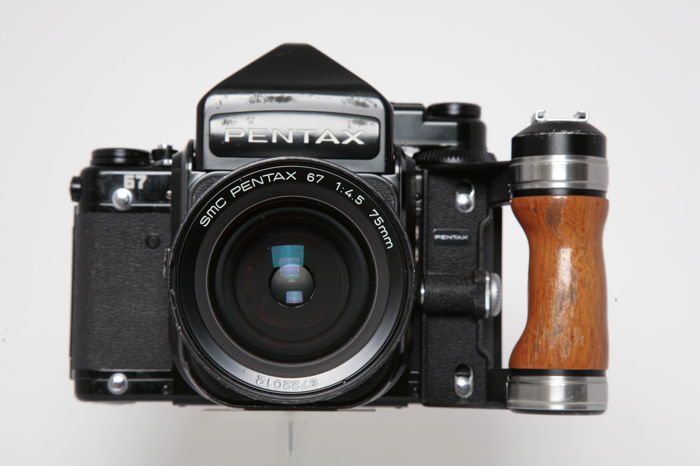
Disclaimer I’ve got one, I’m fanso I’m not 100% objective 😀 In addition, it’s the tool of choice of Nick Brandt for the majority of his work, as well as to Todd Hido for some of his, and they’re some of my favorite photographers!
All models can have a measure who depends on the prism installed on it. Some prisms are without measurement, others with, so be sure to check when you buy (even on the latest model!). Here are the models of Pentax 67 :
- The Asahi Pentax 6×7 is the first model, released in 1969. No mirror lock function. It’s this option that distinguishes it from the…
- Asahi Pentax 6×7 MLU (for “Mirror Lock-up”). This option is useful if you are doing long exposure: the mirror being huge On this camera, its movement at shutter release can spoil your long exposures, and this option helps prevent that.
- The Pentax 67which has therefore slightly changed its name (we lose the “Asahi”, and “6×7” becomes “67”).
- The Pentax 67 IIthe latest version, which wins a prism with 3 metering modes and exposure compensationas well as a much more ergonomic handle on the right side. It is also significantly more expensive, of course, while the rest of the range is much more affordable.
Beyond the prism, you can also purchase various sights including breast sights if you wish.
But the true strength of Pentax 67 is in its optics rangeincluding the legendary 105mm f/2.4This is the lens with the largest aperture of all 6×7 format cameras. And I can tell you it shows! The separation you can get with the background is probably the closest you can get to the large format without having to bother with a chamber.
It’s especially noticeable with a portrait taken from quite a distance, like here:
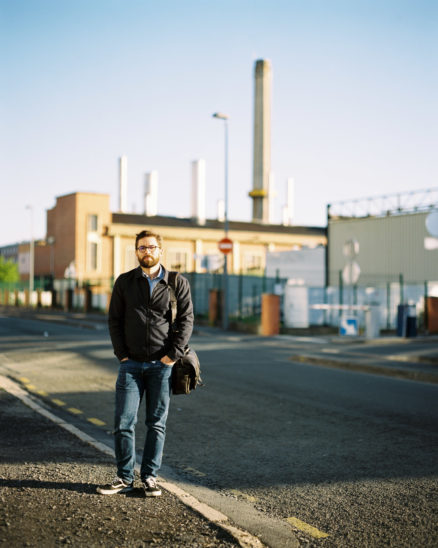
Besides, apart from the Pentax 67 II which is not cheap at all, the other models remain very affordable given what they allow you to do, and their solidity.
Its main defect is obviously its weight and its congestion. They’re real, but to be nuanced compared to other boxes like the Mamiya RB67 that we’ll see below: more than 2kg on the scale and important dimensions it’s not negligible, but I’ve already taken it with me on a trip, and it’s not a huge problem either if you don’t need to walk with 😉.
There are very few real equivalents to Pentax 67. In fact, most of the “competing” devices (which can serve the same purpose) are rather in other families of devices that we will discuss later.
I still can’t finish without mentioning the Pentacon Six TLwhich takes the form of a “big reflex”, but this time with a square format 6×6. Unfortunately, it suffers from reliability concerns (overlapping views), but at 150-200€ with lenshis price is hard to beat!
Selection of telemetric medium formats
As medium formats tend to require large boxes, the family of telemetric medium formats is particularly interesting. There are many models available that I can’t list all of them, so I’ll proceed by brand.
Mamiya telemetric medium formats
Mamiya is a brand that those who started photography with digital cameras probably don’t know, but which has nevertheless offered some of the best cameras ever produced.
In telemetry, we can cite the almost legendary Mamiya 6 (6×6) and Mamiya 7 (6×7), which are interchangeable lens telemetrywhich is almost unique in this category! (there’s also the Fuji GL690)
The Mamiya 6 has only 3 optics available, equivalent 35mm, 50mm and 100mm. Its big advantage is that part of the optical compartment folds into the housing when it is transported, which adds to the compactness of the whole.
The Mamiya 7 does not allow optics to fold, but it has a much more developed optical offer with equivalent 22mm, 25mm, 33mm, 40mm, 75mm, 105mm.
Fuji telemetric medium formats
Fuji has also developed a wide array from medium format telemetric devices to fixed targetsome of which fold up when stowed away, thanks to the presence of a bellows.
I’m going to mention several models that I think are emblematic here, but be careful: there are often several variants with close namess, which have significant differences (most often their focus changes, but sometimes not only). So do your research well so that you don’t accidentally buy a camera that is different from what you want! 🙂
Let’s start with the Fuji GW690also known as the “Texas Leica“(for the big pickup, checkered shirt and shotgun in the glove box I guess :D). Yes I know, I already said it above, but you may have forgotten since this article is the size of a novel 😀
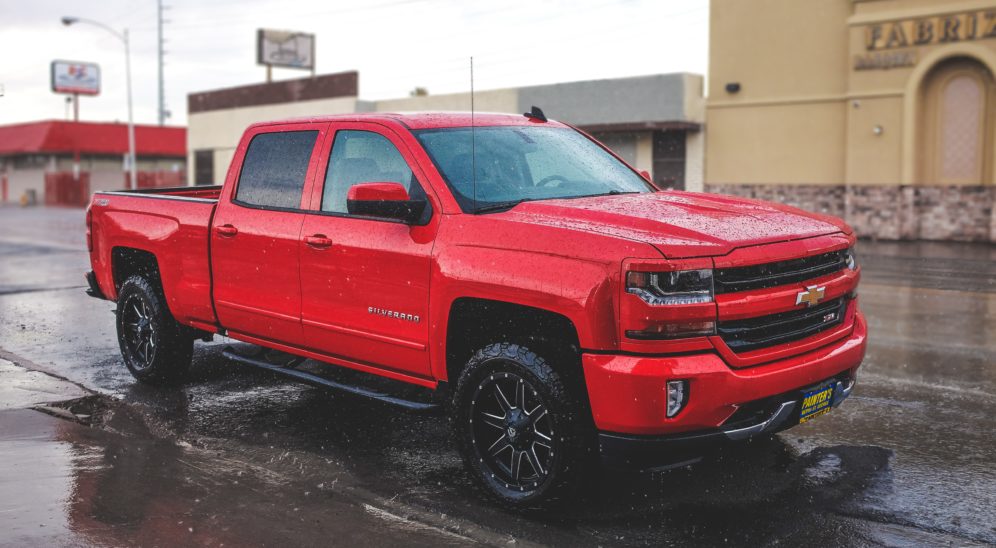
We call it that because it is to Leica what the Pentax 67 is to a 35mm SLR: the same in (much) bigger. But for this size, it produces 6×9 negatives (which is huge, more than 6 times the surface of the 24×36!).with its 90mm f/3.5 (35mm equivalent) optics.
Other examples include the Fuji GF670a 6×7 foldable very compact, with its 80mm f/3.5 lens (40mm equivalent). It has all the modern functions (aperture priority, exposure compensation), and therefore is not given at all today. It can even do 6×6!
On the other hand, the bellows is fragile, so be careful to buy a copy in good condition.
And finally, a little smaller still, we can mention the GS645he too. foldablebut a lot cheaper, because it’s a little more basic.
He even has a cousin, the Fuji GA645 that has autofocus!
The Plaubel Makina 67
Personal pleasure: I can’t finish this part without telling you about the Plaubel Makina 67…one of my favorite things about design.
It’s a direct competitor to the Fuji GF670 we saw above: also foldable, its optics open at f/2.8, but it only goes up to ISO 1600 instead of 3200, and despite its cell that gives you indications, it doesn’t have an aperture priority mode.
SLR (SLR) selection
Now let’s move on to the cute part of the family: the bi-lens reflex. You’ve got to admit it, an LRT always looks good.. One immediately has the impression of having travelled in time, and they have a special charm. Note that, with one notable exception, LRTs generally have a pair of fixed targets.
The Rolleiflex
Let’s start with the king with the Rolleiflex, the most emblematic of them all. There have been dozens of models, produced from 1929 to 2002 while remaining very similar in form and function. There are mainly two ranges, one with a objective at f/3.5 and the other with a objective at f/2.8.
As a result, given the breadth of the range, if you’re looking for something without really knowing where to start, you’re going to find models between 300 and 4000€.which may come as a surprise.
It would be too long to make a complete guide, so I invite you to do some research, starting with these buying guides (unfortunately in English, but with a Google Translate hit you should understand the main points):
The Yashica Mat 124G
If you can’t find what you’re looking for among the Rolleiflexes (probably because of the budget), you can turn to the cheaper alternative, the Yashica Mat 124g.
He’s very popular because he has a great value Even if its construction is not the all-metal construction of a Rolleiflex, you can have very good results with it, for a very contained price (less than 200€). Its 80mm f/3.5 lens is not as good quality as the Rollei’s (especially at full aperture), but for this price, it’s hard to ask for more!
The Mamiya C330
I needed to talk to you about this box, for the simple reason that it’s one of the only LRTs to have interchangeable lenses ! There are to my knowledge 7 optics available, from 55mm (35mm equivalent) to 250mm (161mm equivalent).
It is a very sophisticated housing, which also accepts different sights with or without measurementIt has a very good ergonomic design, handles, different sighting glasses and a very good ergonomics. It’s kind of the ultimate achievement of the TLR if you will.
The price remains rather contained considering its particularity: about 400-500€ for the housing with the 80mm f/2.8 (the standard optics). Of course, if you want other lenses, the bill can quickly go up 🙂.
[t
For a little less money, you can turn to the Mamiya C220the cheaper version, which takes the same optics but overlooks some automatisms (This includes arming the shutter separately from the film advance, which involves two operations between each frame). The camera body, on the other hand, is lighter of 300g, which is not negligible!
I have the impression that there are fewer of them for sale, but the price is more like 250-300€.
Selection of modular silver medium formats
To finish this selection of medium format cameras, I’m going to tell you a little bit about the “modulables” family. Some of the cameras I presented you before already had a certain modularity: the Mamiya C330 mentioned above allows you to change viewfinder for example, and it was even the case with some professional 35mm reflex cameras. (my favorite Nikon F3 allows for example to have a chest viewfinder!).
But there’s a whole category of devices designed for modularity. Indeed, the body itself is only a cube that contains the shutter, and on top of it we come to graft the lens, the viewfinder, and what for me really characterizes this family: a back that contains the film.
It has one great advantage, it’s that…we can change the film before we finish it.This is very handy for shooting the same subject in black and white and in color, or simply to have a more sensitive film on hand at the end of the day.
I’m going to sort them by negative format here, from the smallest to the largest.
Medium formats that can be modulated in 6×4.5
Let’s start with the Mamiya 645. There are several generations of models, and you have to be careful because the original Mamiya 645 and the Mamiya 645 1000S don’t have interchangeable backs. They are not bad cameras for all that, but personally I find that we lose a little bit the interest of the format.
So I’m going to focus on Mamiya 645 Super and Pro. The beauty of the modular system is that you can either have a very compact devicewith a simple chest viewfinder (and therefore foldable), or on the contrary a prism with a measuring device (larger), and a motorized handle (for better ergonomics and automatic film advance.
Anyway, depending on which option you choose, it’s going to be pretty much versatile.
In addition, Mamiya’s range of optics is highly developed, including the excellent Mamiya 80mm f/1.9This is the medium format optic with the largest aperture, which will give you a depth of field similar to that of a 105mm f/2.4 mounted on Pentax 67! It is one of those few optics so legendary that they are sometimes a good reason alone to buy the body to put them on!
The TTL prism also has a very reliable and reputable measurement, which will ensure a good exposure of your photos.
A cheaper chouilla alternative is the Bronica ETR / ETRS / ETRSi. It is also a good option, the main difference being the central leaf shutter in the optics which makes them most suitable for flash photography (synchronisation is possible at all speeds). Note that there are a few on Mamiya 645 too, but this is a minority.
Apart from that, the housing is a bit heavier, and there is no 80mm f/1.9, but you won’t be disappointed either.
Medium formats that can be modulated in 6×6
I obviously couldn’t do an article on film cameras without mentioning the legendary Hasselbladin this case the “V-System” family, of which you may be familiar with the famous Hasselblad 500 C/M.
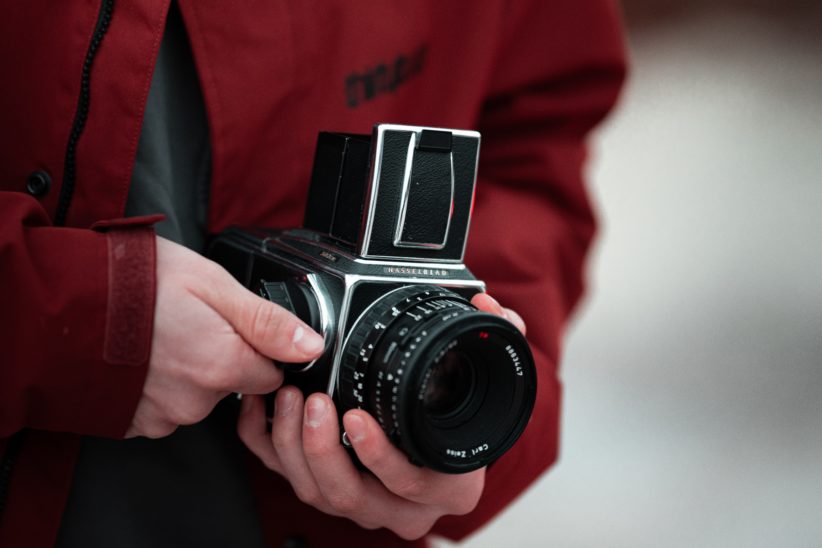
A bit like Leica, Hasselblad is a brand that has its fan community, and still produces quality digital medium format cameras today.
Like the modulators we saw earlier, you can change the backIf a “traditional” Hasselblad usually has a chest viewfinder “like a TLR” you can also place a prism on it.
But there is no handle I know of, so you won’t be able to hold it “like a 35mm reflex”.
The Hasselblad “V-System” features many models with different possibilitiesthat would deserve a full article. The best resource I found is this very complete article on Emulsive, unfortunately in English.
For this article, I’m only going to give you a plug for the Hasselblad 500 C/M, probably the most famous model.
I started with Hasselblads because they’re absolutely essential, but note that there are some cheaper alternativess, including the Bronica SQwhich offer more or less the same type of solution, but with the possibility of having a handle.
Medium formats that can be modulated in 6×7
Finally, let’s talk about the 6×7 modulables, with the king of the category: the Mamiya RB67 or RZ67 (the next generation). You are starting to get used to modulables: interchangeable optics, interchangeable back, chest viewfinder or prism.
With this size of negative, we’re talking about a heavy machineand given its ergonomics, let’s just say it: it was designed to be used in the studio, painting on a tripod.
Annie Leibovitz, for example, used one.
And you’re starting to get used to the more affordable alternative: Bronica is still here, this time with the show… GS.
Selection of rooms (large format)
To finish this selection, I will briefly tell you about the rooms. Briefly because, as I said before, not only are you probably not going to start with a room, but I don’t have one myself, so my knowledge is more limited.
The first model that seems to me to be unavoidable are the Intrepid rooms. It is a small British brand that developed a few years ago by selling rooms at a reduced price, thanks to the use of affordable materials (plywood) and 3D printing for plastic parts (herbal!).
So you’ll have a new room, at a very reasonable price (about 320€ for the 4×5 model), and therefore a priori no problem of functioning, and in any case the support of a still alive company.
It’s my opinion the best option to start the large format without investing too much.
You’ll still have to add one or more lenseswhich you’ll find used. The Intrepid chamber fits all Copal shutter optics and all Linhof/Technika lens plates.
It’s probably gibberish if you don’t know anything about it yet, but the translation is: you won’t have any trouble finding compatible lenses.
Apart from Intrepid, there are also more high-end chamber brands, such as : Gibellini, Shen Hao, Calumet or Chamonix.
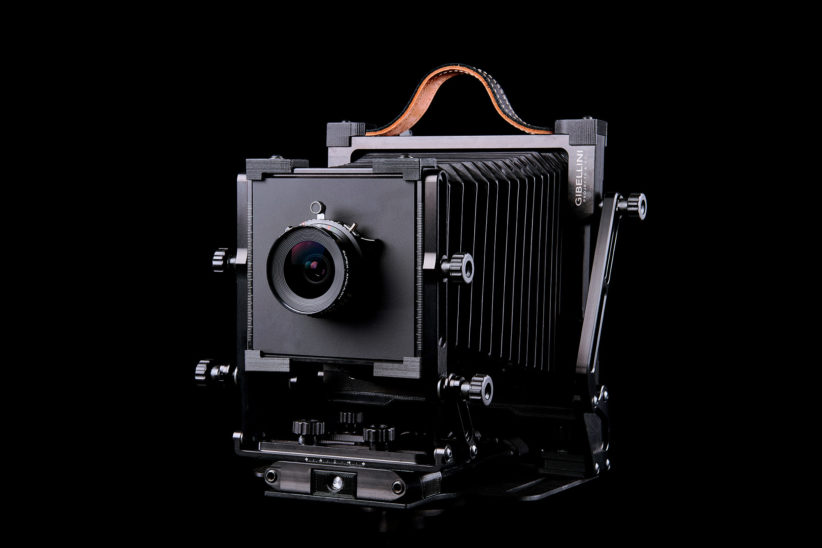
How to buy a second hand silver camera?
Now that you’ve read this huge file, you might have an idea of what you want…. Even you fell in love with a particular case.
Of course, you’ll have to buy it second-hand! And it’s not as reassuring as buying a new one in a well-established shop, where you can complain if it doesn’t fit.
We will therefore see on which sites to buy and how to avoid scams, good practices when selecting ads, how to search properly, and what to check when buying.
Where can I buy a used camera?
You can occasionally find a camera for sale in your city’s film lab. (if there is still one), or in a second hand resale store (the famous “Cash”), but let’s be honest: if you’re looking for a particular model, you’re going to have to search the internet.
The two king sites are obviously eBayand the Good Cornerfor the French in any case (I understand that the equivalent was 2nd hand in Belgium, Kijiji in Quebec and Ricardo in Switzerland 😉 ).
The Good Corner, and the pitfalls to avoid
Le Bon Coin is rather intended for sale “from hand to hand”, and even if shipping is more and more done, you’re not going to find a lot of people who accept a secure payment method.and it’s the place to lots of scams.
A hand-delivery can be tempting to see the material, but it doesn’t necessarily guarantee that the camera will be problem-free, especially since you can’t check all the problems without having shot and developed a film.
But at least you’re sure you have a device for the money you’re giving.
That said, if you’re looking for a specific model, you can probably wait a long time to find it in your corner.
On the other hand, in the case of a shipment, you must have a golden rule: NEVER pay by anything other than Paypal or the secure payment method of the Good Corner. NOTHING ELSE.
If the seller refuses, just wait for the next opportunity.
And when you pay by Paypal, please think about do NOT send in “send money to a friend” mode.In this case Paypal does not take any fees from the seller, but they do not guarantee anything.
While sending the money in the mode “purchase of goods or services”If you do not receive anything, you can be reimbursed by PayPal. Yes, you can, it’s up to the seller to prove that he sent you the item….
If you want to be VERY careful, you can even filming the opening of your package (point out the number), in case there’s nothing in it.
Another caution to have: if the salesman tells you he didn’t get the money or whatever, check in your Paypal account directly. Don’t rely on emails you receive, which may be false. If you go to your account, you will see what was actually recorded as a transaction.
Note that this is even more valuable as a seller: a common scam is to send a fake email to the seller claiming that the funds have been paid out. If you don’t see them in your account, it’s a scam. In this case, ask the person for their mailing address and then report the scammer on the government’s dedicated website.
eBay, buyer’s paradise?
I’ll be direct: I infinitely prefer eBay to the Good Place.whether as a salesman (on The Good Corner they try to rip me off every 3 seconds, it’s annoying)or as a buyer (on The Good Corner most sellers refuse secure payments, either because they are scammers, or because they do not know how to protect themselves from all the scams by checking directly on their account).
eBay is an international platform with an excellent reputation and a large number of sellers, both private individuals and professionals.
You will therefore find your happiness at any time, but not always at a “bargain” price (we talk below about how to know the right price).
Here’s what to watch out for in order to have a good eBay experience:
- The vendor reputation. Each seller is rated by the buyers (and vice versa), so you can easily see if you are dealing with someone serious.
- That the seller accepts Paypal. This is usually the case (Paypal and eBay belong to the same box), but it is to be checked.
- Read the descriptionand don’t hesitate to ask the seller questions. Some devices are sometimes sold “for parts”, read carefully and look at the pictures 🙂.
- Check the location carefullyand provide for customs duties accordingly.
If you are in European Unionyou will have no customs charges for a package from another EU country. That said, you’ll also find a lot of announcements from the United Statess, but especially the Japan (especially if you are looking for appliances in perfect condition).
I have personally bought most of my devices from professional Japanese dealers, and I have always been very happy. On the other hand, of course, you have to plan a significant delay (normally 2-3 weeks), and the significant customs charges.
You can use the calculator on Julien Delmas’ blog to forecast your customs fees.
Personally, I really like eBay for shopping: I sometimes explore the Good Corner just in case, but overall it doesn’t serve me much.
How to search properly?
This may sound silly, but think about it… look for the different possible variants the brand name (e.g. Fuji / Fujica / Fujifilm depending on the era and model), the name of your camera (Ricoh GR3 or Ricoh GR III), with or without spaces, etc.
On eBay the search sometimes corrects itself, and professional sellers put all the variants, but you might miss an individual who didn’t think of it and typed in the wrong name.
To determine the price, consider look at recent successful sales. Just do a little operation in the search:
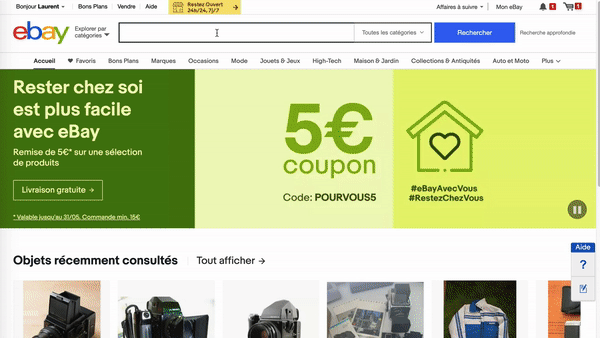
What are the criteria to be checked?
Of course, these are second-hand devices, so you have to check a few things before you buy. Many professional sellers will specify them in the text of their ad, but if not, do not hesitate to ask for them :
- Are there any mushrooms in the lens? (if so, run away)
- Does the measure is functional and reliable? (if there is one of course)
- Is that… the device was recently tested with a film to see if there was any light leaks ? Or have the foams been changed?
- Does the advancing film Well?
- Do the speeds are right ? (Over time, they can get stuck)
Other than that, one counterintuitive point: a device that’s “never been used”, that’s not necessarily a good point.. These are often very mechanical objects, and the parts are not designed to remain stationary for long periods of time. So ask if it’s been tested.
Even though I personally like to receive a clean device, in practice, it’s not a problem. Dust is not very important.. You will be able to clean your camera without too much trouble, especially since there is no problem of dust on the sensor with a silver camera 🙂.
To go further
We’re coming to the end of this big file on the choice of a silver camera. I have good news and bad news:
- The good news is that you now have a good knowledge of what exists, of your choices, and that you’re going to be able to choose correctly ;
- The bad news is that it’s not quite over yet: if you have specific criteria, you’ll probably have to do more research to refine your selection.
Indeed, as I said at the beginning, this article is not intended to be exhaustive. There are others who do better on the material than I do.
So I’m going to give you my favourite sources of information, in both French and English:
- 🇫🇷Benber, which offers you both tests of many often inexpensive devices, of the device selections by category to go beyond what I’ve been able to do here, and a daily selection of good deals on eBay (if he displays it, it means the price is reasonable). Thanks to him for rereading this article and making the tables of all the models presented 🙂.
- 🇫🇷Film is Undead, which offers some interesting camera tests.
- 🇫🇷35mm compact, which has a lot of info despite its slightly dated design 🙂
- 🇫🇷Lumières in a box in the same vein.
- I cannot fail to mention the two silver photo wikis 🇺🇸Camera-wiki.org and 🇺🇸Camerapedia of course.
- 🇺🇸35mmc which is an excellent resource for advanced device testing (category “review” in the menu).
- 🇺🇸Emulsive which is also full of them.
- And finally 🇺🇸The Phoblographer who have some nice articles (but they don’t only talk about silver).
Voilà! We’re getting to the end of this big piece, I hope it’s helped you find your happiness. in the jungle of film cameras. If you have any questions, ask them in commentand the next time you see someone wondering how to choose, you can tell them… share this link 🙂

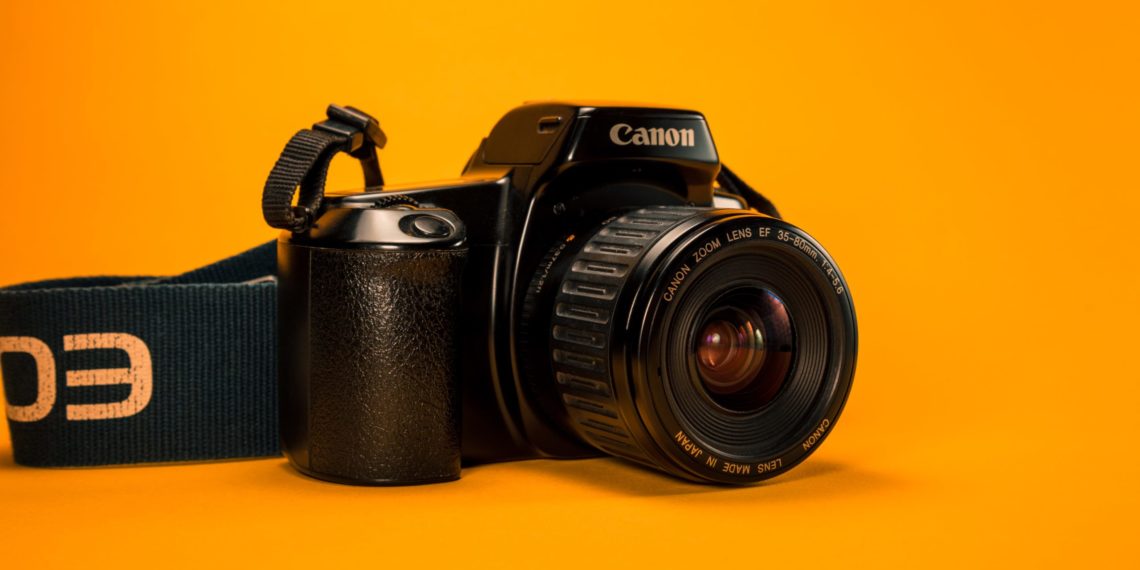


Discussion about this post